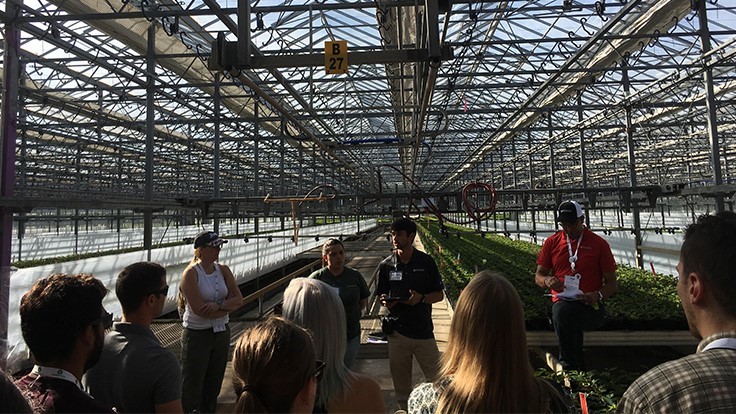Metrolina Greenhouses Assistant Grower Carleton Stuecker, second from right, speaks to Plug & Cutting Conference attendees about scouting for insect pests during the Pest Management Workshop for Propagators. On Wednesday, attendees of AmericanHort ’s Plug & Cutting Conference visited Metrolina Greenhouses in Huntersville, North Carolina. They were greeted by an indoor basketball court, numerous microwaves and break tables for employees, conveyor belts, cutting planters and a vast overlook where a 40-acre greenhouse expansion is underway. The Pest Management Workshop for Propagators at Metrolina, a biological controls-focused educational event, was hosted by Juan Ponce of Metrolina, Suzanne Wainwright-Evans of Buglady Consulting , Ron Valentin of BioWorks , Jeff Gabric of BASF and Jaclyn Bennett of Parabug . The workshop included a presentation on scouting from Buglady Consulting Owner Wainwright-Evans and Metrolina Assistant Grower Carleton Stuecker. As part of its scouting practices, Metrolina uses sticky cards throughout its production. The best way to read a sticky card is to read from the top left and look over and down like a book, following the squares, Stuecker said. In addition, growers should take damaged plants and gently brush them, he said. “Here, the main thing that I like to start with is look for movement,” he said. “Most things aren’t going to move, so look for the movement. Once you’ve identified the movement, you can use your magnifying glass and see what you have there.” At times, a magnifying glass won’t detect small mites, so growers will need to look at them through a microscope if they have one, Stuecker said. “We’ve marked the major pests and insects that we have here,” he said. “Then we’ll go in, and whatever our recordings were for the area, we’ll put in as a location — the crop that we found it on and the numbers of insects that we have.” Then, the operation puts the information in a database and decides how to proceed from there. Growers need to be specific in their biocontrol efforts, Wainwright-Evans said. She gives the example that in the past, when growers saw thrips, they would assume they were […]






